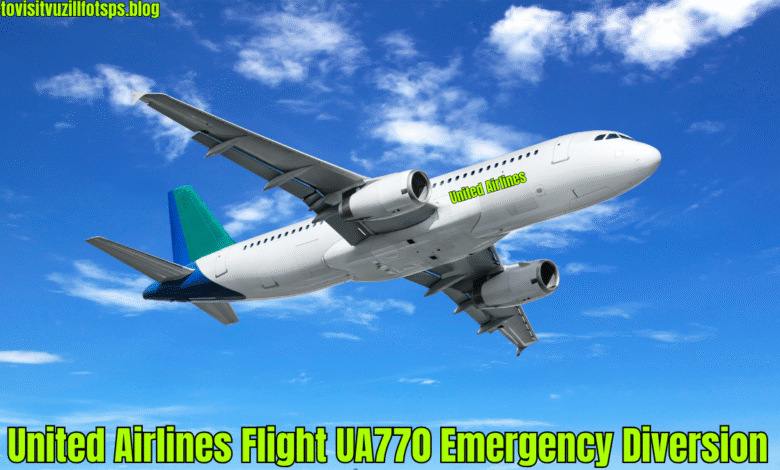United Airlines Flight UA770 Emergency Diversion: What Really Happened

Introduction: When Routine Flights Become Headlines
Air travel is one of those modern miracles we often take for granted. You walk into a terminal, board a plane, watch a few movies, and before you know it, you’re on another continent. But sometimes, that seemingly routine journey takes a sudden turn. This was the case with United Airlines Flight UA770 Emergency Diversion, a scheduled transatlantic flight from Barcelona, Spain (BCN) to Chicago O’Hare (ORD).
On May 27, 2025, passengers aboard this Dreamliner experienced an unexpected change of plans when the aircraft declared a general emergency and diverted to London Heathrow Airport (LHR). While the words “emergency” and “diversion” may sound alarming, what unfolded was actually a textbook example of aviation safety at work.
In this article, we’ll break down everything about UA770’s diversion—from the technical side of what happened, to how the crew, with their unwavering professionalism, handled it, to what passengers experienced on the ground. We’ll also explore broader lessons in aviation safety and why events like these, though rare, prove the resilience of the industry.
The Journey of UA770: A Snapshot of the Flight
United Airlines Flight UA770 isn’t just a random route. It’s a well-established long-haul transatlantic service connecting Barcelona, one of Europe’s busiest leisure hubs, with Chicago, a major U.S. gateway. The route usually operates with a Boeing 787-9 Dreamliner, one of the most modern aircraft in United’s fleet United Airlines Flight UA770 Emergency Diversion.
The Dreamliner is designed for long-haul comfort: better humidity levels, higher cabin pressure, larger windows, and more efficient engines. It’s the kind of plane you’d want to be on for an 8- to 9-hour crossing of the Atlantic. Passengers that morning likely expected a smooth, uneventful flight—time for a nap, some in-flight meals, and maybe a binge-watch session United Airlines Flight UA770 Emergency Diversion.
For the first part of the journey, everything seemed routine. The aircraft climbed to cruising altitude, navigation systems were stable, and cabin service was underway. But behind the calm cabin atmosphere, the cockpit instruments began detecting a potential issue with the pressurization system. That’s when the ordinary turned extraordinary.
Squawk 7700: Aviation’s Universal Emergency Signal
When Flight UA770’s crew declared an emergency, they did so by transmitting Squawk 7700 on their transponder. For those outside aviation, this might sound like jargon, but it’s actually a critical part of how planes communicate with the ground.
A “squawk code” is a four-digit number entered into the aircraft’s transponder to identify itself to radar controllers. Most flights use standard codes assigned by air traffic control. But there are three special codes reserved worldwide United Airlines Flight UA770 Emergency Diversion:
- 7500: Hijacking
- 7600: Radio communication failure
- 7700: General emergency
By squawking 7700, the pilots of UA770 were essentially sending an all-caps, bold, flashing distress call across European skies. Air traffic control centers immediately knew this was a serious situation, and the aircraft received priority handling.
The beauty of this system is that it’s simple, universal, and automatic. Controllers don’t need a long explanation; they instantly understand that the flight is facing a potential life-threatening issue. Within minutes, UA770 had a clear path to its diversion airport, with every other aircraft moved aside to make way.
What Went Wrong: Pressurization Anomaly Explained
So, what triggered all of this? Initial reports indicate that the Dreamliner experienced a cabin pressurization system alert. That might sound technical, but let’s break it down United Airlines Flight UA770 Emergency Diversion.
Airplanes fly at altitudes where the outside air pressure is far too low for humans to survive. To counter this, the cabin is pressurized to simulate conditions at about 6,000–8,000 feet above sea level. This is controlled by an environmental control system (ECS), which regulates air flow, temperature, and pressure inside the cabin.
On UA770, a sensor indicated that something wasn’t right—perhaps a valve malfunction, or a misreading from the pressurization control system. While oxygen masks didn’t deploy, the warning itself was serious enough to require caution. Pilots are trained to treat every pressurization alert as urgent because loss of cabin pressure can escalate quickly.
By declaring an emergency and descending to a lower altitude, the crew reduced any risk to passengers. The diversion to Heathrow wasn’t just about fixing the plane—it was about ensuring that if the system worsened, they’d already be close to safety.
The Pilots’ Response: Calm Under Pressure
Pilots train for years to handle scenarios just like this. What might seem frightening to passengers is often part of a pilot’s routine simulator training United Airlines Flight UA770 Emergency Diversion.
When the pressurization alert appeared, the flight deck crew would have:
- Checked the warning: Determining whether it was an actual system fault or a false alarm.
- Coordinated with ATC: Declared the emergency and received instructions for diversion.
- Planned descent: Gradually lowering altitude to safer levels while maintaining passenger comfort.
- Communicated with the cabin crew: Ensuring everyone was informed without sparking panic.
This structured, step-by-step response is what keeps modern aviation safe. Even though the words “emergency” were used, at no point was the aircraft spiraling out of control. It was a managed, professional operation from start to finish United Airlines Flight UA770 Emergency Diversion.
Passengers later reported that the announcements were not just clear, but also reassuring. By the time the Dreamliner touched down in London, the mood on board was far calmer than you might expect, a testament to the crew’s ability to maintain a sense of normalcy in a potentially stressful situation.
The Passenger Experience: Inside the Cabin
For passengers, diversions like this often feel surreal. One moment you’re halfway through a movie or dozing off, the next you’re told the plane is diverting due to a technical issue.
On UA770, reports suggest the cabin crew handled the situation with professionalism and empathy. Passengers weren’t left in the dark; instead, they were informed that a technical alert had occurred and the flight would be landing in London as a precaution. Importantly, there was no sense of panic, since oxygen masks didn’t deploy and the descent, expertly managed by the pilots, felt smooth.
Once on the ground, the airline quickly arranged for disembarkation. Travelers were rebooked on later flights to Chicago or given hotel accommodations in London. For many, the inconvenience was minimal compared to the reassurance that safety came first. Some passengers even described it as “a story to tell”—a rare glimpse into how aviation safety protocols really work United Airlines Flight UA770 Emergency Diversion.
Heathrow: The Perfect Diversion Choice
Why Heathrow? When UA770 declared its emergency, the pilots had multiple airports within range. But Heathrow stood out for several reasons.
First, it’s one of the largest and best-equipped airports in the world, with emergency response teams trained for virtually any scenario. Second, it has multiple long runways capable of handling a fully loaded Boeing 787. And third, it’s a United Airlines partner hub, making passenger re-accommodation far smoother.
When the Dreamliner landed on Runway 27R, emergency services were already on standby. Thankfully, they weren’t needed beyond observation. The aircraft was then guided to a gate, where technicians and ground staff were prepared for rapid assessment.
Choosing Heathrow wasn’t just about geography—it was about infrastructure, safety, and minimizing disruption for passengers.
Behind the Scenes: Maintenance and Investigation
Once UA770 was safely parked, the spotlight shifted to the technical teams. Pressurization issues can stem from many sources United Airlines Flight UA770 Emergency Diversion:
- Faulty sensors
- Outflow valve malfunctions
- Environmental control system glitches
- Electrical or software anomalies
United’s maintenance engineers, in coordination with Boeing and aviation regulators like the FAA and EASA, began investigating the root cause. Flight data recorders provided exact readings of cabin pressure and system alerts, which are invaluable for diagnostics.
Even though the incident caused no injuries, every emergency declaration is treated seriously. Investigations like this help airlines spot patterns, improve training, and prevent future disruptions.
Lessons Learned: Aviation Safety in Action
At the end of the day, Flight UA770’s diversion isn’t a story of danger—it’s a story of safety. Here are the big takeaways:
- Redundancy works: Multiple systems caught the pressurization anomaly early.
- Training pays off: Pilots and cabin crew handled the situation smoothly.
- Infrastructure matters: Heathrow’s emergency readiness ensured a safe landing.
- Passengers were protected: No injuries, no chaos, just precaution.
Incidents like this remind us that air travel, while not immune to hiccups, is one of the safest modes of transportation in the world. For every high-profile emergency, thousands of successful diversions and landings don’t even make the news United Airlines Flight UA770 Emergency Diversion.
FAQs About United Airlines Flight UA770 Emergency Diversion
Q1: Why did Flight UA770 divert to London Heathrow?
A: A suspected pressurization system anomaly triggered an emergency declaration, and Heathrow was the safest, best-equipped airport within reach.
Q2: What is “Squawk 7700”?
A: It’s the universal aviation transponder code for a general emergency. Entering it alerts all controllers to prioritize the aircraft immediately.
Q3: Were passengers in danger?
A: No. The precaution was taken before the situation became critical. The plane remained fully under control throughout.
Q4: What happens to passengers after an emergency diversion?
A: Airlines rebook travelers on new flights, provide meals and accommodations if needed, and ensure their journey continues with minimal disruption United Airlines Flight UA770 Emergency Diversion.
Q5: Is this emergency common?
A: Diversions happen, but full Squawk 7700 emergencies are rare. Most flights operate without incident, and when they do occur, safety protocols are highly effective.
Conclusion: A Story of Safety, Not Fear
When the words “emergency” and “diversion” hit the headlines, it’s easy to imagine chaos in the skies. But the reality of United Airlines Flight UA770 tells a very different story. This was a case study in aviation safety at its best: early detection, professional response, calm communication, and a safe outcome for everyone on board.
For passengers, it may have been an unexpected layover in London instead of a direct trip to Chicago. But in aviation, safety always takes priority over schedules. UA770 proved once again that modern air travel isn’t just about speed and convenience—it’s about resilience, redundancy, and above all, protecting lives.
The next time you hear about a “diversion,” remember: it’s not a sign that something went disastrously wrong. It’s proof that the systems in place are doing exactly what they’re supposed to do—keeping people safe when the unexpected happens.


